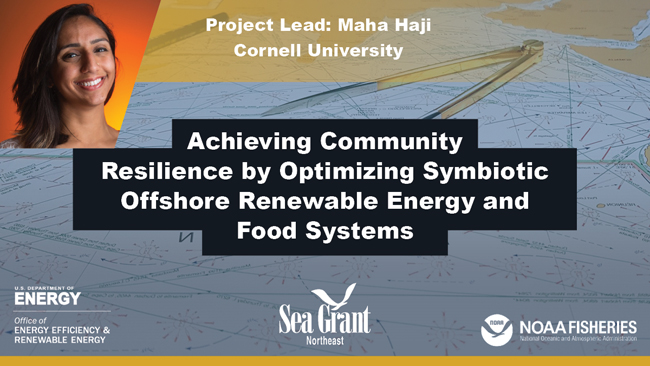Sea Grant, DOE, NOAA Fisheries fund six projects, including one in New York, for the coexistence of offshore energy with Northeast fishing and coastal communities
Contact:
Gwen Gallagher, Coastal Climate Specialist, New York Sea Grant, P: (631) 632-8730, E: geg59@cornell.edu
New York, NY, May 19, 2022 - The Northeast Sea Grant Consortium — in partnership with the U.S. Department of Energy’s Wind Energy Technologies Office and Water Power Technologies Office, and NOAA’s Northeast Fisheries Science Center — today announced six projects to advance social science and technology research on offshore renewable energy in the Northeast United States.
The half dozen projects selected are led by principal investigators in three northeast U.S. states (NY, ME, RI):
- Maha Haji, Cornell University - Achieving Community Resilience by Optimizing Symbiotic Offshore Renewable Energy and Food Systems
- Heather Leslie, University of Maine - Building Capacity for Participatory Approaches to Community Resilience and Ocean Renewable Energy Siting
- Kate Beard-Tisdale, University of Maine - Can Proprietary Commercial Lobstering Data be Used to Inform Offshore Wind Development?
- Alison Bates, Colby College - Community Engagement and Stakeholder Perceptions of Floating Offshore Wind
- Emily Diamond, University of Rhode Island - Evaluating Messaging, Communication Networks and Public Engagement on Offshore Wind Development in Southern New England
- David Bidwell, University of Rhode Island - Regional Community Attitudes Regarding Procedural and Distributive Justice Dimensions of Southern New England Offshore Wind Development
Here are more details on the project from New York:

Maha Haji, Cornell University - Achieving Community Resilience by Optimizing Symbiotic Offshore Renewable Energy and Food Systems
Though current mapping tools exist for the region (for instance the National Ocean Data Portal), they are designed for short-term planning (i.e., does this proposed offshore wind lease intersect with any commercial fishing grounds?). None currently incorporate ocean data sets that will be key to making future decisions (i.e., if this wind farm is placed here, is it possible to later incorporate a wave-powered aquaculture farm in this location as well?). The tool developed in this proposed effort would empower stakeholders to make more informed decisions that could substantially increase economic efficiencies in the long term, thereby increasing economic resiliency.
A goal post of the project is to develop a mapping tool that can be used in the marine spatial planning process in the Northeast United States to highlight potential conflicts as well as synergies that may exist between offshore wind farm developers, commercial and recreational fishers, aquaculture farmers, and wave energy developers. Allowing for the integration of multiple ocean uses in the same area will enable symbiosis between renewable energy and food systems, and the economic efficiencies that come with this symbiosis would contribute to community resilience, growth, and stability.
The mapping tool will be built by first developing a simulation model of potential wave-powered aquaculture farm designs for the case of Integrated Multi-Trophic Aquaculture as well as finfish farming. This simulation model will then be used in conjunction with a geographical information system (GIS)-based model that synthesizes available datasets of information relevant to offshore wind farm developers, wave energy developers, commercial and recreational fishers, as well as aquaculture farmers. Finally, basic Multi-Criteria Decision Analysis will be incorporated in the tool to enable users to explore and find suitable offshore areas of the Northeast for development.
More Information: Partners
The Northeast Sea Grant Consortium consists of the New York, Connecticut, Maine, MIT, New Hampshire, Rhode Island, and Woods Hole Sea Grant Programs. Sea Grant’s mission is to enhance the practical use and conservation of coastal, marine and Great Lakes resources in order to create a sustainable economy and environment.
NOAA’s Northeast Fisheries Science Center works with the Greater Atlantic Regional Fisheries Office to ensure informed management decisions based on sound science, promoting sustainability of marine life, supporting fisheries and coastal communities, and generating economic opportunities and benefits from the use of these resources.
DOE’s Wind Energy Technologies Office and Water Power Technologies Office are committed to developing and deploying innovative technologies for clean, domestic power generation from natural renewable resources such as wind, hydropower, waves, and tides. The mission is to enable energy science research, development, and testing of new technologies to advance innovative energy systems in the United States.
More Info: New York Sea Grant
New York Sea Grant (NYSG), a cooperative program of Cornell University and the State University of New York (SUNY), is one of 34 university-based programs under the National Oceanic and Atmospheric Administration’s National Sea Grant College Program.
Since 1971, NYSG has represented a statewide network of integrated research, education and extension services promoting coastal community economic vitality, environmental sustainability and citizen awareness and understanding about the State’s marine and Great Lakes resources.
Through NYSG’s efforts, the combined talents of university scientists and extension specialists help develop and transfer science-based information to many coastal user groups—businesses and industries, federal, state and local government decision-makers and agency managers, educators, the media and the interested public.
The program maintains Great Lakes offices at Cornell University, University at Buffalo, SUNY Oswego and the Wayne County Cooperative Extension office in Newark. In the State's marine waters, NYSG has offices at Stony Brook University and Cornell Cooperative Extension of Nassau County on Long Island; at Brooklyn College, with New York City Department of Environmental Protection in Queens and at Cornell Cooperative Extension in NYC and Elmsford and Kingston in the Hudson Valley.
For updates on Sea Grant activities: www.nyseagrant.org has RSS, Facebook, Twitter, Instagram, and YouTube links. NYSG offers a free e-list sign up via www.nyseagrant.org/nycoastlines for its flagship publication, NY Coastlines/Currents, which is published quarterly.